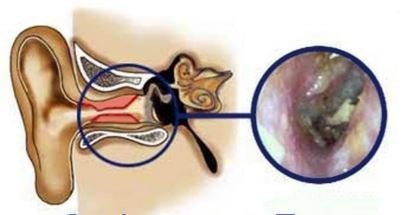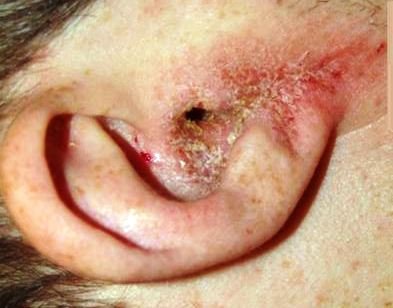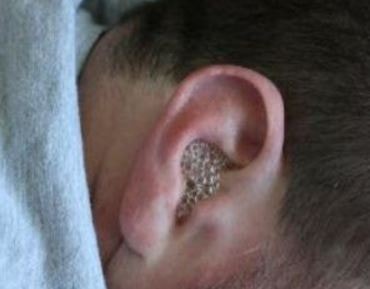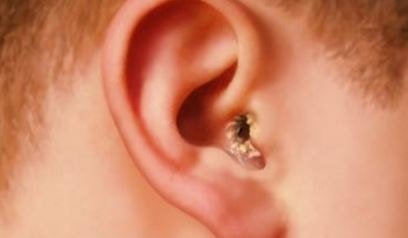Swimmer’s Ear
What is Swimmer’s Ear?
Swimmer’s ear is also referred to as external otitis, otitis externa or acute external otitis. This involves an inflammation and infection affecting the outer ear and the ear canal. It has been associated with otitis media due to the existing earache that it causes to an affected person.

An essential characteristic of this problem is the inflammation in the ear canal, which can be a secondary problem with an existing dermatitis with no associating microbial infection; or it can be a result of an active fungal or bacterial infection. The ear canal appears swollen and is painful to touch, whether in the presence of an infection or not.
The ear infection that develops in the outer canal is running from the eardrum going to the external portion. This begins after a swimming session when polluted water remains in the ear giving a moist environment inside, which aids in the growth of bacteria.
Other factors which may lead to this problem is the constant application of cotton swabs, inserting fingers into the ears or any other objects which can damage the thin layer lining of the skin in the ear canal.
Signs and Symptoms
The main complain of a person with this ear problem is an ear pain and is considered the sole symptom which is directly related with the severity of an existing acute otitis externa. The ear pain becomes worse when the external ear is being touched and pulled gently, either for viewing or examination purposes.

Mild symptoms:
- Tragus pain when pressure is applied during an ear examination
- Lack of cerumen in the affected ear
- Presence of clear, odorless fluid ear discharges
- Feelings of itchiness in the affected ear
- Slight redness in the inner part of the ear
Moderate Symptoms :
- Increasing pain in the affected ear
- Itchiness becomes more intense
- Pus discharges noted with excessive fluid drainage
- Redness becomes more extensive inside the ear
- Feelings of fullness in the swollen ear
- Temporary conductive hearing loss in a swollen ear canal and with discharges
Advanced symptoms:
- Feelings of severe pain radiating to nearby areas like the face, the neck or side of the head
- Fever
- Outer ear becomes swollen and reddened in color
- Swollen lymph nodes in the neck
- Existing complete blockage of the ear canal and hearing affected
Causes of Swimmer’s Ear
Acute external otitis refers to a bacterial infection caused by some types of bacteria thriving in the water or soil, which invades the ear, such as Pseudomonas specie, Staphylococcus specie or by Streptococcus specie.
The swimmer’s ear infection is the result of an excessive water exposure from activities related to swimming, scuba diving, kayaking, water surfing, and other water sports. The collection of water in a person’s ear canal predisposes bacterial growth due to moisture when water is trapped by the ear wax.
Ear injuries in the form of abrasions or cuts in the ear canal lining from frequent application of cotton swabs can also lead to bacterial infection.
Another cause could be a result of sensitivity reactions due to types of earrings used or hair products touching the external ear, which end up to skin irritations or skin allergies which all enhances an ear infection.
Diagnosis
The occurrence of a swimmer’s ear is being diagnosed by a physician through an examination of the ear canal and visualization of the eardrum. Complete history taking also helps with the presenting clinical manifestations.
Further ear testing by an ear specialist is highly recommended if upon assessment and evaluation, the eardrum appears damaged and torn.
In cases where the ear infection does not respond to treatment done, the physician may resort to take discharge samples or debris from the ear for culture and sensitivity test of the drainage; and laboratory analysis to identify the causative bacteria in a later appointment schedule.
Home Remedies
Simple home remedies can be achieved with the following tips to remember:
- Keeping the ears dry at all times, use of ear plugs or cotton ball moistened with vaseline as an ear plug during bathing time is preferable
- Avoid scratching, inserting fingers or applying cotton swabs into the inner part of the ears to prevent worsening the ear problem
- Hearing aids must not be used until such time that there is no more ear swelling and ear discharges have discontinued
- Always follow doctor’s advice for prescribed medications in a specified time to complete at home
- Prevent infections by slightly acidifying the ear canal with a homemade mixture of 50% alcohol, 25% distilled water and 25% white vinegar
Treatment
The main goal of treatment is directed at curing the ear infection and to achieve back the healthy condition of the ear canal. Otitis externa is considered a self-limiting condition that allows healing by itself; however if the infection type is from moderate to severe type, and the ear canal remains moist for some reasons, spontaneous improvement might not be attained. Treatment can be done through:
- Proper ear care as directed to avoid infections
- Use of antibiotic ear drops for completed doses and with correct ear instillation as prescribed by the physician for the infection
- Use of over the counter pain relievers like acetaminophen, naproxen or ibuprofen
- Antihistamines to minimize the itchiness of the ears
- Expose the hair to a dryer to dry the ears after shower is done
- Avoid water immersion or water sports activities during treatment time until the problem is resolved
Pictures


References:
http://www.mayoclinic.org/diseases-conditions/swimmers-ear/basics/tests-diagnosis/con-20014723
http://www.medicinenet.com/otitis_externa/page3.htm
http://www.webmd.com/cold-and-flu/ear-infection/tc/swimmers-ear-otitis-externa-topic-overview
Rosenfeld, R. M.; Schwartz, S. R.; Cannon, C. R.; Roland, P. S.; Simon, G. R.; Kumar, K. A.; Huang, W. W.; Haskell, H. W.; Robertson, P. J. (3 February 2014). “Clinical Practice Guideline: Acute Otitis Externa Executive Summary”. Otolaryngology — Head and Neck Surgery 150 (2): 161–168.
Wang MC, Liu CY, Shiao AS, Wang T (August 2005). “Ear problems in swimmers”. J Chin Med Assoc 68 (8): 347–52.
Roland P, Stroman D (2002). “Microbiology of acute otitis externa”. Laryngoscope 112 (7 Pt 1): 1166–77.
